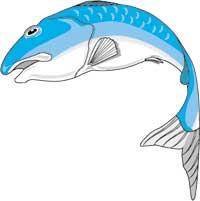Myth of blue fish
The properties of blue fish have not been recognized until a few years ago; being very fatty it was not considered advisable and the little fish that was eaten was white. But seeing that the rate of heart disease of the Eskimo living in the Arctic was so low, they began to investigate their diet. The blue fish they consume themselves realized that they reduced the solid fats of the blood and, therefore, protected them with diseases of the cardiac and circulatory apparatus.
Unlike meat, most of the fish's fats are liquid at normal temperature and are called oils. Likewise, the group of blue fish is formed by fish with a fat content of more than 5% and, of course, the more fat they contain more kilocalories we will ingeriate.

But there are differences between the blue fish: the most fatty are those that have 10 g of fat or more than 100 g of fat. Among them are the eel, the angula, the tuna, the verdel and the salmon. Among those who have between 5-10% fat are anchovy, bonito, mero, palometa, sardines and chicharro.
If you're in the fish shop and want to know if the fish is blue or white, just look at the fish tail, if it looks like an open fork is blue. In general, blue fish is very mobile and makes long walks in search of warm waters. Therefore, like humans, it has to accumulate energy, which makes it accumulate fat.
Did you know that the most appreciated drink is blue fish in winter and white fish in summer? Well, yes, that's right. To protect against the cold it develops more fat in winter, exceeding 5% and in summer about 2%. In addition to the time of year, the life cycle and food also influence the accumulation of fats. For example, anchovy has a lot more fat before laying than later.
The proteins that contain fish are easy to digest and their value is equivalent to that of meat. Among the vitamins and minerals stand out the amount of vitamin A and D, as well as iodate wealth. For all the reasons indicated it is recommended to consume fish approximately 4 times per week, being the most appropriate variation, being two of these four blue fish.
Buletina
Bidali zure helbide elektronikoa eta jaso asteroko buletina zure sarrera-ontzian











